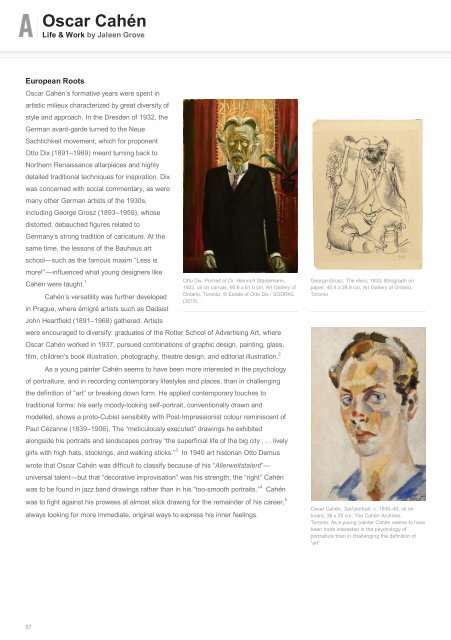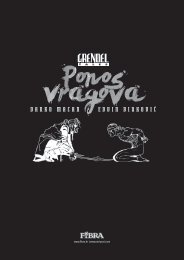Oscar Cahén
Art-Canada-Institute_Oscar-Cah%C3%A9n
Art-Canada-Institute_Oscar-Cah%C3%A9n
Create successful ePaper yourself
Turn your PDF publications into a flip-book with our unique Google optimized e-Paper software.
<strong>Oscar</strong> <strong>Cahén</strong><br />
Life & Work by Jaleen Grove<br />
European Roots<br />
<strong>Oscar</strong> <strong>Cahén</strong>’s formative years were spent in<br />
artistic milieux characterized by great diversity of<br />
style and approach. In the Dresden of 1932, the<br />
German avant-garde turned to the Neue<br />
Sachlichkeit movement, which for proponent<br />
Otto Dix (1891–1969) meant turning back to<br />
Northern Renaissance altarpieces and highly<br />
detailed traditional techniques for inspiration. Dix<br />
was concerned with social commentary, as were<br />
many other German artists of the 1930s,<br />
including George Grosz (1893–1959), whose<br />
distorted, debauched figures related to<br />
Germany’s strong tradition of caricature. At the<br />
same time, the lessons of the Bauhaus art<br />
school—such as the famous maxim “Less is<br />
more!”—influenced what young designers like<br />
<strong>Cahén</strong> were taught.<br />
1<br />
<strong>Cahén</strong>’s versatility was further developed<br />
in Prague, where émigré artists such as Dadaist<br />
John Heartfield (1891–1968) gathered. Artists<br />
Otto Dix, Portrait of Dr. Heinrich Stadelmann,<br />
1922, oil on canvas, 90.8 x 61.0 cm, Art Gallery of<br />
Ontario, Toronto, © Estate of Otto Dix / SODRAC<br />
(2015)<br />
were encouraged to diversify: graduates of the Rotter School of Advertising Art, where<br />
<strong>Oscar</strong> <strong>Cahén</strong> worked in 1937, pursued combinations of graphic design, painting, glass,<br />
film, children’s book illustration, photography, theatre design, and editorial illustration.<br />
As a young painter <strong>Cahén</strong> seems to have been more interested in the psychology<br />
of portraiture, and in recording contemporary lifestyles and places, than in challenging<br />
the definition of “art” or breaking down form. He applied contemporary touches to<br />
traditional forms: his early moody-looking self-portrait, conventionally drawn and<br />
modelled, shows a proto-Cubist sensibility with Post-Impressionist colour reminiscent of<br />
Paul Cézanne (1839–1906). The “meticulously executed” drawings he exhibited<br />
alongside his portraits and landscapes portray “the superficial life of the big city . . . lively<br />
girls with high hats, stockings, and walking sticks.” In 1940 art historian Otto Demus<br />
wrote that <strong>Oscar</strong> <strong>Cahén</strong> was difficult to classify because of his “Allerweltstalent”—<br />
universal talent—but that “decorative improvisation” was his strength; the “right” <strong>Cahén</strong><br />
was to be found in jazz band drawings rather than in his “too-smooth portraits.” <strong>Cahén</strong><br />
was to fight against his prowess at almost slick drawing for the remainder of his career,<br />
always looking for more immediate, original ways to express his inner feelings.<br />
3<br />
4<br />
2<br />
5<br />
George Grosz, The Hero, 1933, lithograph on<br />
paper, 40.4 x 28.9 cm, Art Gallery of Ontario,<br />
Toronto<br />
<strong>Oscar</strong> <strong>Cahén</strong>, Self-portrait, c. 1930–40, oil on<br />
board, 36 x 25 cm, The <strong>Cahén</strong> Archives,<br />
Toronto. As a young painter <strong>Cahén</strong> seems to have<br />
been more interested in the psychology of<br />
portraiture than in challenging the definition of<br />
“art”<br />
57



